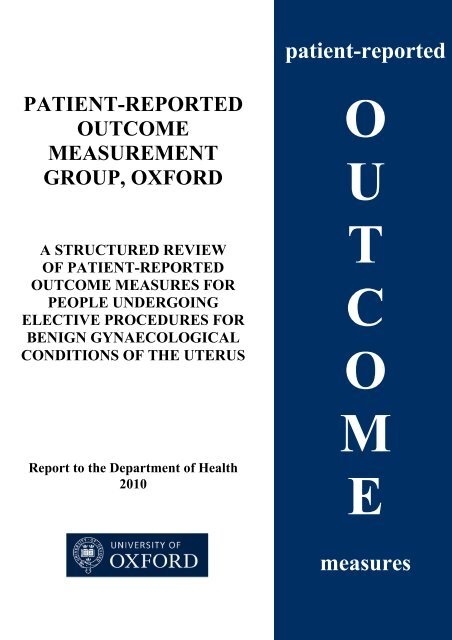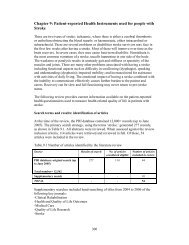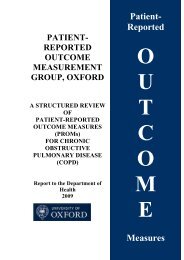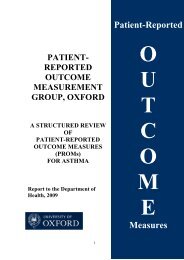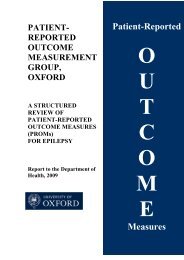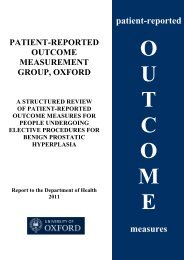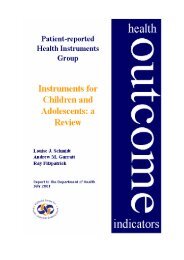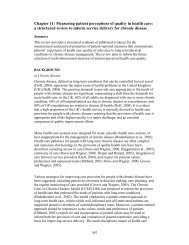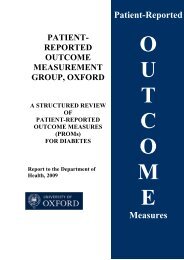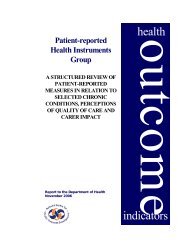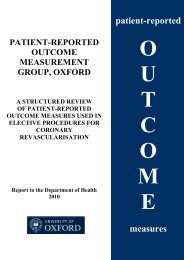2010 review - Patient-Reported Outcomes Measurement - University ...
2010 review - Patient-Reported Outcomes Measurement - University ...
2010 review - Patient-Reported Outcomes Measurement - University ...
You also want an ePaper? Increase the reach of your titles
YUMPU automatically turns print PDFs into web optimized ePapers that Google loves.
patient-reported<br />
PATIENT-REPORTED<br />
OUTCOME<br />
MEASUREMENT<br />
GROUP, OXFORD<br />
O<br />
U<br />
A STRUCTURED REVIEW<br />
OF PATIENT-REPORTED<br />
OUTCOME MEASURES FOR<br />
PEOPLE UNDERGOING<br />
ELECTIVE PROCEDURES FOR<br />
BENIGN GYNAECOLOGICAL<br />
CONDITIONS OF THE UTERUS<br />
T<br />
C<br />
O<br />
M<br />
Report to the Department of Health<br />
<strong>2010</strong><br />
E<br />
measures
A STRUCTURED REVIEW OF PATIENT-REPORTED<br />
OUTCOME MEASURES FOR PEOPLE UNDERGOING<br />
ELECTIVE PROCEDURES FOR BENIGN GYNAECOLOGICAL<br />
CONDITIONS OF THE UTERUS, <strong>2010</strong><br />
Elizabeth Gibbons<br />
Anne Mackintosh<br />
Ray Fitzpatrick<br />
<strong>Patient</strong>-reported Outcome <strong>Measurement</strong> Group<br />
Department of Public Health<br />
<strong>University</strong> of Oxford<br />
Copies of this report can be obtained from:<br />
Elizabeth Gibbons<br />
Senior Research Officer<br />
<strong>Patient</strong>-reported Outcome <strong>Measurement</strong> Group<br />
tel: +44 (0)1865 289402<br />
e-mail: elizabeth.gibbons@dphpc.ox.ac.uk
A STRUCTURED REVIEW OF PATIENT-REPORTED<br />
OUTCOME MEASURES FOR PEOPLE UNDERGOING<br />
PROCEDURES FOR BENIGN GYNAECOLOGICAL<br />
CONDITIONS OF THE UTERUS, <strong>2010</strong><br />
CONTENTS<br />
Executive summary 1<br />
1. Introduction, methods, search terms and results 3<br />
2. Preference-based measures 7<br />
3. Generic PROMs 8<br />
4. Condition-specific PROMs 11<br />
5. Discussion and recommendations 14<br />
Appendix A – Methodological criteria 17<br />
Appendix B – Search strategy 19<br />
Appendix C – Details of PROMs 20<br />
Appendix D - Methods of working, membership and conclusions of multidisciplinary<br />
panel 22<br />
References 28
EXECUTIVE SUMMARY<br />
Aims of the report<br />
The aims of this report are to identify <strong>Patient</strong>-reported Outcome Measures which have<br />
been evaluated with patients undergoing an elective uterine procedure for benign<br />
gynaecological conditions.<br />
The methods of the <strong>review</strong> are described and the results of the search including<br />
sources and search terms used to identify relevant published research. Details of this<br />
evidence are presented firstly for preference-based measures, generic health status and<br />
then condition -specific PROMs. The <strong>review</strong> resulted in the identification of a shortlist<br />
of PROMs which were presented to a multidisciplinary panel for comment. The<br />
<strong>review</strong> of the literature-based evidence and the comments of the multidisciplinary<br />
panel underpin final recommendations to the DH.<br />
PREFERENCE-BASED MEASURES<br />
One preference based measure was included:<br />
a) EQ-5D<br />
GENERIC MEASURES<br />
Two generic measures were included:<br />
a) SF-36<br />
b) SF-12<br />
CONDITION-SPECIFIC QUESTIONNAIRES<br />
Four condition-specific measures were included; one specific to women with fibroids:<br />
a) Uterine Fibroid Symptom and Quality of Life Questionnaire (UFS-QOL).<br />
b) Ruta Menorrhagia Questionnaire<br />
c) Menorrhagia Utility Scale<br />
d) Menorrhagia <strong>Outcomes</strong> Questionnaire<br />
Recommendations<br />
In light of the different procedures and conditions in the evaluations, the EQ-5D and<br />
SF-36 are shortlisted as preference and generic measures depending on purpose of<br />
measurement.<br />
Based on appraisal of evidence by the PROM Group, and taking into account ratings<br />
and comments from the panel, the UFS-QOL is highlighted as an instrument with<br />
good supportive evidence for use with women with fibroids.<br />
There is no instrument with substantive evidence to make clear recommendations for<br />
women with menorrhagia (without fibroids). This finding is consistent with other<br />
<strong>review</strong>s (Clark et al., 2002; Jones et al.,2002).<br />
1
1. INTRODUCTION<br />
<strong>Patient</strong>-reported outcome measures (PROMs) offer enormous potential to improve the<br />
quality and results of health services. They provide validated evidence of health from<br />
the point of view of the user or patient. They may be used to assess levels of health<br />
and need in populations, and in users of services they can provide evidence of the<br />
outcomes of services for the purposes of audit, quality assurance and comparative<br />
performance evaluation. They may also improve the quality of interactions between<br />
health professionals and individual service users.<br />
Lord Darzi’s Interim Report on the future of the NHS recommends that patientreported<br />
outcome measures (PROMs) should have a greater role in the NHS (Darzi<br />
2007). The new Standard NHS Contract for Acute Services, introduced in April 2008,<br />
included a requirement to report from April 2009 on patient-reported outcome<br />
measures (PROMs) for patients undergoing Primary Unilateral Hip or Knee<br />
replacements, Groin Hernia surgery or Varicose Vein procedures. Furthermore, Lord<br />
Darzi’s report ‘High Quality Care for All’ (2008) outlines policy regarding payments<br />
to hospitals based on quality measures as well as volume. These measures include<br />
PROMs as a reflection of patients’ experiences and views. Guidance has now been<br />
issued regarding the routine collection of PROMs for the selected elective procedures<br />
(Department of Health, 2008) and since April 2009, the routine collection of PROMs<br />
for the selected elective procedures has been implemented and is ongoing. This report<br />
expands on this by <strong>review</strong>ing the evidence of PROMs for other common elective<br />
procedures.<br />
There are three broad categories of PROMs: generic health status, preference-based,<br />
and condition- or population-specific-measures. Generic instruments comprise items<br />
intended to be relevant to the widest range of patient conditions and the general<br />
population. Preference-based measures are also broad in content but additionally<br />
provide utilities or values regarding health (for use in, for example, cost-utility<br />
analyses of interventions). Condition-specific instruments are often more focused on a<br />
particular disease or health condition (for example, diabetes), a patient population (for<br />
example, older people), a specific problem or symptom (for example, pain), or a<br />
described function (for example, activities of daily living). For any given area of<br />
health, condition-specific instruments may have greater clinical appeal due to the<br />
inclusion of content specific to particular conditions, and the likelihood of increased<br />
responsiveness to interventions.<br />
It has been recommended that a combination of a generic or utility measure with a<br />
specific measure be used in the assessment of patient-reported health outcomes, on the<br />
grounds that the complementary content of the two types of measure, when combined,<br />
should assess a full range of aspects of health relevant to the particular population<br />
concerned. However, consensus is often lacking as to which instrument to use for<br />
specific purposes and contexts (Garratt et al., 2002). Structured <strong>review</strong>s of PROMs for<br />
specific health conditions or populations can provide guidance for selection. An<br />
evidence-based approach strengthens recommendations from these <strong>review</strong>s.<br />
Selection criteria have been defined for assessing the quality of existing PROMs<br />
(McDowell, 2006; Fitzpatrick et al., 1998). These include measurement issues, such<br />
3
as reliability, validity, responsiveness and precision, as well as practical issues, such<br />
as acceptability and feasibility.<br />
Gynaecological procedures<br />
Two main common procedures are carried out in the UK for women suffering with<br />
menorrhagia. The 2008-9 HES data (main procedure) report that there were similar<br />
numbers of procedures performed for Therapeutic endoscopic operations on the<br />
uterus- 33,546 and Abdominal excision of uterus-32,144. The therapeutic endoscopic<br />
interventions include different methods of ablation for the treatment of menorrhagia<br />
and embolisation for fibroids. The less invasive techniques are now recommended as<br />
an alternative to hysterectomy for some women with heavy menstrual bleeding (NICE<br />
2007).<br />
Aim of the report<br />
The aim of this report is to identify <strong>Patient</strong>-reported Outcome Measures (PROMs)<br />
which have been evaluated with patients undergoing elective procedures for benign<br />
gynaecological conditions.<br />
Structure of the report<br />
The methods of the <strong>review</strong> are described and the results of the search including<br />
sources and search terms used to identify relevant published research. Details of this<br />
evidence are presented for preference-based measures, generic health status and<br />
condition or procedure-specific PROMs. The full body of evidence and a short-list of<br />
PROMs were presented to a multidisciplinary panel for comment; details of their<br />
comments and ratings are reported in Appendix D. The PROMs Group considered the<br />
combination of the <strong>review</strong> of evidence and the views of the multidisciplinary panel<br />
before reaching its own conclusions and recommendations.<br />
Methods<br />
Methods adopted were as described in previous <strong>review</strong>s performed by the PROM<br />
group, Oxford. Comprehensive searches were conducted; articles retrieved were<br />
assessed for relevance and evidence of measurement performance and operational<br />
characteristics abstracted for each PROM identified.<br />
a) Search sources and terms<br />
Several sources were searched to identify relevant articles. Full details of search<br />
strategies are found in Appendix A.<br />
The searches were conducted using three main sources.<br />
Records in the bibliography database were searched using the keyword ‘gynaecology’<br />
up to December 2005. This database was compiled by the PROM group with funding<br />
from the Department of Health and the Information Centre, and hosted by the<br />
<strong>University</strong> of Oxford 1 .<br />
1 The PROMs bibliography can be accessed free of charge at http://phi.uhce.ox.ac.uk/home.<br />
4
The Ovid search engine was used to explore a number of relevant databases 2 from<br />
January 2006 until March <strong>2010</strong>, using a comprehensive search strategy (see appendix<br />
A).<br />
Supplementary searches included scanning the reference lists of <strong>review</strong> articles and<br />
others, checking instrument websites, where found, and drawing on other<br />
bibliographic resources. Hand-searching of titles of key journals from October 2009<br />
to April <strong>2010</strong> was also conducted. The following journals were selected:<br />
<br />
<br />
<br />
<br />
Health and Quality of Life <strong>Outcomes</strong><br />
Quality of Life Research<br />
Obstetrics and Gynaecology<br />
British Journal of Obstetrics and Gynaecology<br />
The following supplementary sources were searched:<br />
<br />
<br />
<br />
The National Institute for Health Research: Health Technology Assessment<br />
Programme<br />
The Cochrane library http://www.thecochranelibrary.com/<br />
The EQ-5D website; reference search facility (http://www.euroqol.org/)<br />
b) Inclusion criteria<br />
Published articles were included if they provided evidence of measurement and/or<br />
practical properties of relevant PROMs (Fitzpatrick et al., 1998).<br />
Population<br />
Women with menorrhagia, dysmenorrhoea, fibroids<br />
Women undergoing vaginal or abdominal hysterectomy<br />
Women undergoing endoscopic interventions of the management of the above<br />
conditions<br />
English-speaking populations.<br />
Study design selection<br />
studies where a principal PROM is being evaluated;<br />
studies evaluating several PROMs concurrently;<br />
trials or studies evaluating the effectiveness of interventions; where a PROM<br />
is used as an endpoint;<br />
prospective studies measuring patient-reported outcomes where data is<br />
available for a PROM in terms of measurement performance or operational<br />
characteristics.<br />
2 Four databases were searched using Ovid: AMED (Allied and Complementary Medicine), EMBASE,<br />
PsycInfo, Ovid MEDLINE(R) In-Process & Other Non-Indexed Citations and Ovid MEDLINE(R).<br />
5
Specific inclusion criteria for generic, preference-based and condition-specific<br />
instruments<br />
the instrument is patient-reported;<br />
there is published evidence of measurement reliability, validity or<br />
responsiveness following completion in the specified patient population;<br />
evidence is available from English-language publications, and instrument<br />
evaluations conducted in populations within the UK, North America, or<br />
Australasia;<br />
the instrument will ideally be multi-dimensional. It is at the <strong>review</strong>er’s<br />
discretion to include PROMs which are specific to a health condition but have<br />
a narrow focus, for example, a specific dimension of health, such as<br />
symptoms.<br />
Exclusions<br />
studies using clinician-rated instruments;<br />
studies evaluating the performance of non-patient reported measures of<br />
functioning or health status where a PROM is used as a comparator;<br />
studies using incomplete versions of instruments.<br />
c) Data extraction<br />
For all PROMs included in the <strong>review</strong>, evidence is reported for the following<br />
measurement criteria:<br />
reliability<br />
validity<br />
responsiveness<br />
precision<br />
Operational characteristics, such as patient acceptability and feasibility of<br />
administration for staff, are also reported.<br />
d) Assessment of methodological quality of PROMs<br />
Assessment and evaluation of the PROMs was performed by means of the criteria<br />
described in Appendix B.<br />
Searches identified 992 potentially relevant records. When assessed against the <strong>review</strong><br />
inclusion criteria, 46 articles were included in the <strong>review</strong> (Table 1).<br />
Table 1: Number of articles identified by the search<br />
Source Results of search Number of articles<br />
included in <strong>review</strong><br />
PROM bibliography: 16,054 292 16<br />
Ovid 2006-<strong>2010</strong> 700 18<br />
Hand searching - 12<br />
TOTAL 992 46<br />
6
2. PREFERENCE-BASED MEASURES<br />
One generic preference-based measure was identified:<br />
a) EQ-5D<br />
a. EQ-5D (The EuroQol Group, 1990)<br />
The European Quality of Life instrument (EuroQol)-EQ-5D), was developed by researchers in five<br />
European countries to provide an instrument with a core set of generic health status items (The<br />
EuroQol Group, 1990; Brazier et al., 1993). There are two sections to the EuroQol: the EQ-5D or<br />
five-dimensional index and the EQ thermometer. The EQ-5D assesses health across five domains:<br />
anxiety/depression (AD), mobility (M), pain/discomfort (PD), self-care (SC), and usual activities<br />
(UA). Each domain has one item and a three-point categorical response scale; health ‘today’ is<br />
assessed. Weights based upon societal valuations of health states are used to calculate an index<br />
score. A score profile can be reported. The EQ thermometer is a single 20-cm vertical visual<br />
analogue scale with a range of 0 to 100, where 0 is the worst and 100 the best imaginable health.<br />
Five studies were identified, three in the UK.<br />
The EQ-5D scores discriminated women with tiredness which was associated with<br />
dysfunctional uterine bleeding, with lower scores than those without tiredness in a<br />
study reporting financial and quality of life burden (n=237) (Frick et al., 2009).<br />
Discriminative validity is also reported in a UK study of 139 women undergoing<br />
different ablation techniques (Abbott et al., 2003). All women reported significantly<br />
lower scores than population norms for both the utility index and the VAS.<br />
The EQ-5D detected significant improvement in the index and VAS scores a small<br />
study evaluating different ablation methods for dysfunctional uterine bleeding (Abbott<br />
et al., 2003). A UK study provides additional evidence in a similar trial (Hawe et al.,<br />
2003).<br />
EQ-5D scores were not discriminative between patients who were satisfied and those<br />
who were not following thermal ablation for the treatment of menorrhagia (Clark &<br />
Gupta. 2004 UK). This was a small study (50 women).<br />
The EQ-5D has been used as a secondary outcome measure in a UK trial of ablation<br />
method, but no important psychometric evidence is reported (Sambrook et al., 2009).<br />
No evaluations were identified with women following hysterectomy.<br />
7
3. GENERIC PROMs<br />
Two generic measures were identified:<br />
a) SF-36<br />
b) SF-12<br />
a. SF-36<br />
The SF-36 is a generic health status instrument with 36 items assessing health across<br />
eight domains (Ware, 1997), namely bodily pain (BP: two items), general health<br />
perceptions (GH: five items), mental health (MH: five items), physical functioning<br />
(PF: ten items), role limitations due to emotional health problems (RE : three items),<br />
role limitations due to physical health problems (RP: four items), social functioning<br />
(SF: two items), and vitality (VT: four items). An additional health transition item, not<br />
included in the final score, assesses change in health. All items use categorical<br />
response options (range: 2-6 options). Scoring uses a weighted scoring algorithm and<br />
a computer-based programme is recommended. Eight domain scores give a health<br />
profile; scores are transformed into a scale from 0 to 100, where 100 denotes the best<br />
health. Scores can be calculated when up to half of the items are omitted. Two<br />
component summary scores for physical and mental health (PCS and MCS,<br />
respectively) can also be calculated.<br />
Twelve studies were included; 8 were from the UK. The SF-36 has been evaluated<br />
with women with different conditions (fibroids, menorrhagia) and following different<br />
elective procedures (ablation, embolisation and hysterectomy).<br />
Factor analysis confirms the relevance of the eight domains (Garrett et al., 1994).<br />
Discriminative validity of the SF-36 was reported in a large UK study (Garrett et al.<br />
1993) which included patients with different health conditions including 271 women<br />
with menorrhagia. Scores for all sub-domains (with PF as an exception) were<br />
significantly lower than population norms denoting poorer functioning. Higher scores<br />
though were reported for women with menorrhagia compared to people with low back<br />
pain for all scales except MH and energy or fatigue. These results were according to<br />
hypotheses. Scores were significantly lower for women with menorrhagia than UK<br />
population norms and all domains detected significant improvement following<br />
ablation (microwave and TCRE) (Cooper et al.,1999 UK).<br />
The SF-36 PCS and MCS scores discriminated women with AUB during the illness<br />
trajectory from baseline to short-term post hysterectomy and long term follow-up.<br />
Baseline scores were significantly lower than population norms; one month post<br />
surgery there were significant improvement in MCS but worsening scores for PCS<br />
however, at one year, significant improvement in scores was reported in both<br />
component summary scores (Kuppermann et al., 2004).<br />
Discriminative validity is reported with scores significantly lower in women (n=263)<br />
with heavy menstrual bleeding prior to treatment than women of similar age from the<br />
general population (Cooper et al., 1999 UK). Similarly, lower scores (RP, BP, GHP,<br />
VT and SF) were reported in a small study (n=46 patients) of women with fibroids<br />
compared to the US female general population (Arleo et al., 2007).<br />
8
Lower scores for RP, BP, SF and MH were significantly predictive of need for<br />
surgery in a group of women attending out-patients with a history of heavy menstrual<br />
bleeding. Although these domains were predictive, the MCS and PCS scores were not<br />
statistically significantly different (Habiba et al., <strong>2010</strong> UK).<br />
All of the SF-36 scales were sensitive in detecting both differences in severity of<br />
symptoms of menorrhagia and change in those who had undergone a surgical<br />
procedure (Coulter et al., 1994 UK). Six of the SF-36 sub-scales (excluding PF and<br />
GHP) detected change in a group of women post surgical intervention for the<br />
treatment of menorrhagia with moderate to large effect sizes reflecting significant<br />
improvement (Jenkinson et al. 1994, UK).<br />
The SF-36 sub-scale scores all detected significant improvement from baseline to<br />
follow-up at 3, 6, 9 and 12 months. There was though substantial loss to follow-up in<br />
this small study of 50 women following uterine fibroid embolisation (Spies et al.,<br />
1999). Significant improvement in scores for SF, RP, RE, Energy and Pain has been<br />
reported in a postal survey (60 to 80 months post procedure) following microwave<br />
endometrial ablation and TCRE. The SF-36 detected within group change (Cooper et<br />
al., 2005 UK). An earlier study by Cooper et al. (1999 UK) provides further evidence<br />
of responsiveness with statistically significant improvement of scores for women<br />
receiving microwave ablation or TCRE (263 patients) and in another study comparing<br />
resection with medical treatment with significant changes in scores detected between<br />
groups and within (Cooper et al., 2001 UK).<br />
In an international study comparing ultrasound surgery and hysterectomy for the<br />
treatment of fibroids reported changed within and between groups suggesting SF-36<br />
responsiveness. However, there were only 19 patients from the UK in this study<br />
(Taran et al., 2009).<br />
Significant improvement of scores within group and between groups was detected in a<br />
UK study of medical vs. ablation methods for the treatment of women with heavy<br />
menstrual bleeding (Cooper et al., 1997). Further discriminative validity and<br />
responsiveness is reported in a trial comparing ablation methods with resection.<br />
Significant improvement in scores was reported following both procedures but<br />
distinctive between group differences in scores per domain discriminated patients<br />
(Sambrook et al., 2009 UK).<br />
Ceiling effects have been reported for PF (42%), RP (45%), SF (27%), and RE (49%)<br />
in 182 patients at baseline with heavy menstrual bleeding (Habiba et al., <strong>2010</strong>, UK).<br />
High patient acceptability is reported in several studies. 90% follow-up has been<br />
reported in a postal survey 60 to 80 months post ablation techniques. This was though<br />
a well conducted trial of two different techniques and a research nurse contacted<br />
participants throughout the study (Cooper et., al 2005 UK). High response rates to<br />
postal completion have been reported at baseline and 8 month follow-up in three UK<br />
studies (Garrett et al., 1993, Habiba et al., <strong>2010</strong>, Jenkinson et al.,1994).<br />
9
. SF-12<br />
A shorter 12-item version of SF-36 was developed using regression analysis; 12 items<br />
were selected that reproduced 90% of the variance in the overall Physical and Mental<br />
Health components of the SF-36. A computer-based scoring algorithm is used to<br />
calculate scores; Physical Component Summary (PCS) and Mental (MCS)<br />
Component Summary scales are generated using norm-based methods. Scores are<br />
transformed to have a mean value of 50, standard deviation (SD) 10, where scores<br />
above or below 50 are above or below average physical or mental well-being,<br />
respectively.<br />
Six studies were identified; three conducted in the UK. The SF-12 has been evaluated<br />
with different populations (fibroids, menorrhagia) and following different elective<br />
procedures (ablation, embolisation and hysterectomy).<br />
Discriminative validity is reported in a UK study of 139 women undergoing different<br />
ablation techniques (Abbott et al., 2003). All women reported significantly lower<br />
scores than population norms for both the PCS and MCS. Scores lower than<br />
population norms were reported in a large study (1493) of women suffering from a<br />
range of non-cancerous gynaecological conditions such as fibroids and heavy<br />
menstrual bleeding (Kuppermann et al., 2007).<br />
Significant score changes were detected in a group of women all receiving a form of<br />
ablation for heavy menstrual bleeding (Abbott et al., 2003). The SF-12 PCS and MCS<br />
detected significant improvement in scores longitudinally in a long-term follow-up of<br />
patients receiving UFE for fibroids (Spies et al., 2007) and embolisation or<br />
hysterectomy (Spies et al., 2004). The SF-12 MCS and PCS detected significant<br />
improvement scores for women in a small study evaluating different ablation methods<br />
for dysfunctional uterine bleeding (Abbott et al., 2003). A UK study provides<br />
additional evidence in a similar trial (Hawe et al., 2003).<br />
The SF-12 has been used as a secondary outcome measure in a UK trial of ablation<br />
method, but no important psychometric evidence is reported (Sambrook et al., 2009).<br />
A five point increase in score has been reported as predictive of satisfaction with<br />
newer techniques in Kuppermann et al. (2007).<br />
10
4. CONDITION-SPECIFIC<br />
Four condition-specific measures were identified; three for menorrhagia and one<br />
specifically for fibroids-UFS-QOL.<br />
a) Uterine Fibroid Symptom and Quality of Life Questionnaire (UFS-QOL).<br />
b) Ruta Menorrhagia Questionnaire<br />
c) Menorrhagia Utility Scale<br />
d) Menorrhagia <strong>Outcomes</strong> Questionnaire<br />
a) Uterine Fibroid Symptom and Quality of Life Questionnaire (UFS-QOL).<br />
Thirteen studies were included in the <strong>review</strong>; 3 in the UK.<br />
Literature <strong>review</strong>, focus groups with patients and clinical opinion informed 37 items<br />
in two sub-scales: Symptom Severity Scale (8 items) and HRQL (29 items). The<br />
HRQL sub-scales are Concern, Activities, Energy, Mood, control, Self-consciousness,<br />
Sexual function. Responses are obtained on a five level Likert scale ranging from<br />
‘none of the time’ to ‘all of the time’ for HRQL and ‘not at all’ to ‘a very great deal’<br />
for the Symptom severity questions. A recall period of three months is chosen to<br />
allow for the variability in the severity and duration of menses.<br />
The development study included 110 patients and 29 normal participants (Spies et al.,<br />
2002). Exploratory factor analysis supports the single sub-scale for symptom severity<br />
and the six sub-scales for HRQL. Internal consistency of all sub-scales are greater<br />
than 0.80.<br />
Reproducibility is reported with ICCs ranging from 0.76 to 0.93 (range 7 to 33 days<br />
post-test). Construct validity is supported with moderate correlation of scores for the<br />
Activities sub-scale and the SF-36 Bodily Pain scale (0.64) and the Menorrhagia<br />
Questionnaire scales (0.44 to 0.76). Discriminative validity is reported with<br />
significantly higher level of distress and lower HRQL than normal population scores<br />
(Spies et al., 2002).<br />
Statistically significant change (improvement in scores) was reported for all subscales<br />
in 81 women undergoing uterine artery embolisation for the treatment of<br />
symptomatic fibroids. Furthermore, the change in symptom severity was significantly<br />
associated with the change in total HRQL and Global satisfaction scores (Smith et al.,<br />
2004). Further evidence of responsiveness is reported with statistically significant<br />
improvement in scores for women undergoing myomectomy (60) and UAE (149)<br />
(Goodwin et al., 2006). Further evidence is reported with significant improvement of<br />
scores in women following thermoablation for fibroids in a small sampled study (49<br />
participants) in the UK (Smart et al., 2006). This is replicated in a study evaluating<br />
thermoablation (MEgFUS) with significant improvement in mean change in scores<br />
which were greater than 10 (Stewart et al., 2006 UK). Significant improvement in<br />
scores was reported in one small study (36 patients) comparing different embolic<br />
agents (Spies et al., 2005a). Significant change was also detected from baseline to 6<br />
and 12 month follow-up following uterine embolisation for fibroids in a large study<br />
(1700 patients) (Spies et al., 2005b).<br />
11
The Symptom Severity Scale detected substantial improvement in scores in a small<br />
study of 35 women undergoing percutaneous radiofrequency thermal ablation for<br />
fibroids at one and 6 months post procedure (Kim et al., 2007). Additional evidence of<br />
responsiveness is reported in a multicentred study which includes a UK population<br />
with significant improvement in symptoms (SSS) (Stewart et al., 2007). The SSS and<br />
the HRQL scales detected significant improvement in scores in a large group of<br />
women undergoing UAE for fibroids (n=1,782). Mean symptom scores and HRQL<br />
scores improved 41 points (p
c) Menorrhagia Utility Scale<br />
Items for this measure were derived from interviews with women referred to a<br />
gynaecology clinic for the treatment of menorrhagia. Items within domains were rated<br />
using a VAS to describe utility weights for the measure with 100 women from the UK<br />
with heavy menstrual bleeding. Four responses are obtained for six items: Practical<br />
difficulties, Social Life, Psychological health, Physical health and well-being,<br />
work/daily routine, Family life and relationships. Scores are obtained by summation<br />
of the scores for each item and represent an overall utility for the patients current<br />
health status (0 worst affected to 100 unaffected).<br />
Four studies were included; 2 in the UK. All evaluations were with women with<br />
menorrhagia.<br />
Face and content validity is supported from patients evaluation (Shaw et al., 1998<br />
UK).<br />
Low MAS scores were predictive of need for surgery with statistically significantly<br />
lower scores in women not needing surgery (Habiba et al., <strong>2010</strong>).<br />
Responsiveness is reported with significant improvement in Symptoms scores in a<br />
group of women post thermal balloon ablation for menorrhagia (Clark et al., 2004).<br />
Significant change in scores was detected in a large UK study evaluating a<br />
computerised decision aid for the management of menorrhagia with improvement<br />
reported in the intervention group which was consistent with other measures in the<br />
trial (Protheroe et al., 2007).<br />
High response rates reported in 200 patients although questionnaires were completed<br />
in the clinic prior to consultation (Habiba et al., <strong>2010</strong>).<br />
d) Menorrhagia <strong>Outcomes</strong> Questionnaire<br />
This 26 itemed questionnaire was developed in the UK and has four domains:<br />
Symptoms (2), Post-operative complications (3), Quality of Life (7) and Satisfaction<br />
with outcome (5), and non scored items for Treatment (8) and a global evaluation of<br />
symptoms (1) (Lamping et al., 1998). Two summary scores are obtained for Quality<br />
of Life/ Satisfaction (12 items) and Global outcome (17 items).<br />
Two UK studies were included although none are within the last few years.<br />
Internal consistency was adequate with alpha greater than 0.70 for summary scales<br />
and item total correlations acceptable for most items greater than 0.3 and retest<br />
reliability acceptable (Lamping et al., 1998). Discriminative validity is reported with<br />
women with greater severity of symptoms reporting poorer questionnaire scores and<br />
convergent validity with moderate correlation of score between the MOQ and the<br />
NHP. Discriminative validity is reported in a small study (66 patients) with<br />
significantly different scores between women undergoing laser ablation compared<br />
historical controls (women who had undergone hysterectomy) (Hindley et al., 2002<br />
13
UK). The women in the hysterectomy group had significantly higher total scores but<br />
the quality of life scores were similar between the two groups.<br />
The developmental study reported good precision with no floor or ceiling effects and<br />
patient acceptability with very low missing data.<br />
The questionnaire was developed to evaluate the outcomes of all surgical<br />
interventions for the treatment of menorrhagia. It was specifically developed as a<br />
single questionnaire which could be administered once following treatment therefore<br />
not needing a pre-treatment assessment for comparison. The questions are framed to<br />
elicit an assessment of the patient’s current symptoms and quality of life compared to<br />
prior to the operation. Reliance on post-treatment retrospective items contrasts with<br />
more common practice to assess change in health status from PROMs administered<br />
before and after an intervention.<br />
Other measures<br />
Some very limited evidence was identified for the Pictorial Blood Loss Assessment<br />
Chart (Duleba et al., 2003, Busfield et al., 2005). It was considered not to be an<br />
appropriate instrument for use in the NHS due to its narrow dimension of the<br />
measurement of menstrual flow and volume.<br />
5. DISCUSSION AND RECOMMENDATIONS<br />
Table 3 shows the appraisals of the evidence for each of the PROMs identified in this<br />
<strong>review</strong>.<br />
One preference based measures was identified in the <strong>review</strong>: the EQ-5D. Some good<br />
evidence of discriminative validity and responsiveness is reported including some<br />
studies in the UK. This evidence only relates to women with menorrhagia and<br />
following ablation methods of treatment. No evidence was reported with women post<br />
hysterectomy.<br />
Two generic measures were included in the <strong>review</strong>: SF-36 and the SF-12.<br />
The SF-36 presents more evidence than the SF-12 with the majority of studies from<br />
the UK. Some positive evidence of construct validity, responsiveness and patient<br />
acceptability is presented for the SF-36 but floor and ceiling effects are reported. The<br />
evidence for the SF-12 is very limited to some support for construct validity and<br />
responsiveness.<br />
Four condition specific measures were identified: Uterine Fibroid Symptom and<br />
Quality of Life Questionnaire (UFS-QOL), Ruta Menorrhagia Questionnaire,<br />
Menorrhagia Utility Scale and the Menorrhagia <strong>Outcomes</strong> Questionnaire.<br />
The most convincing evidence is reported for the UFS-QOL with good measurement<br />
performance and patient acceptability. This includes some UK evidence. Two domain<br />
scores are generated for Symptoms and Quality of life. However, it may be considered<br />
burdensome for patient completion to some extent as there are 37 items. Although it<br />
appears highly relevant in terms of content and focus for women with fibroids, this<br />
14
does limit its utility for women with menorrhagia without fibroids who undergo either<br />
ablation or hysterectomy.<br />
The three other instruments presented (RMO, MUS and MOQ) have been developed<br />
in the UK but with very little evidence to support implementations in the NHS.<br />
Slightly more persuasive evidence is reported for the Menorrhagia Utility Scale with<br />
the added appeal of generating a utility value. It is however a very brief measure in<br />
terms of number of items and may not capture domains relevant to patients.<br />
Others have noted that whilst personal concerns and health-related quality of life is of<br />
importance in this area, there is a marked paucity of validated condition-specific<br />
PROMs to assess outcomes of interventions for women with menorrhagia (Clark et<br />
al., 2002; Jones et al.,2002).<br />
Recommendations<br />
In light of the different procedures and conditions in the evaluations, the EQ-5D and<br />
SF-36 are shortlisted as preference and generic measures depending on purpose of<br />
measurement.<br />
Based on appraisal of evidence by the PROM Group, and taking into account ratings<br />
and comments from the panel, the UFS-QOL is highlighted as an instrument with<br />
good supportive evidence for use with women with fibroids.<br />
There is no instrument with substantive evidence to make clear recommendations for<br />
women with menorrhagia (without fibroids). This finding is consistent with other<br />
<strong>review</strong>s (Clark et al., 2002; Jones et al.,2002).<br />
15
Table 3: Appraisal of PROMs included in the <strong>review</strong><br />
PROM Reproducibility Internal Validity - Validity - Responsiveness Interpretability Precision Acceptability Feasibility<br />
consistency content construct<br />
Preference-based measures<br />
EQ-5D 0 n/a 0 ++ ++ 0 0 0 0<br />
Generic measures<br />
SF-36 0 0 0 +++ +++ 0 - ++ 0<br />
SF-12 0 0 0 ++ ++ + 0 0 0<br />
Condition-specific measures<br />
UFS-<br />
+ + + ++ +++ 0 0 ++ 0<br />
QOL<br />
RMQ + + + 0 + 0 0 0 0<br />
MUS 0 0 + 0 + 0 0 + 0<br />
MOQ + + + + 0 0 + + 0<br />
16
Appendix A: Appraisal of the methodological quality of PROMs<br />
A simple rating scale (Table i) was used to rate the sum total of evidence available for<br />
each dimension or criterion against which PROMs were assessed. The dimensions or<br />
criteria are summarised in Table ii.<br />
Table i: Psychometric and operational criteria<br />
0 not reported (no evaluation completed)<br />
―<br />
Evaluation evidence available indicating<br />
poor performance of instrument<br />
+ Some limited evidence in favour<br />
++ Good evidence in favour<br />
+++ Excellent evidence in favour<br />
17
Table ii: Appraisal criteria<br />
Appraisal component Definition/test Criteria for acceptability<br />
Reliability<br />
Test-retest reliability<br />
Internal consistency<br />
The stability of a measuring instrument over time;<br />
assessed by administering the instrument to<br />
respondents on two different occasions and<br />
examining the correlation between test and re-test<br />
scores<br />
The extent to which items comprising a scale<br />
measure the same construct (e.g. homogeneity of<br />
items in a scale); assessed by Cronbach’s alpha’s<br />
and item-total correlations<br />
Test re-test reliability correlations<br />
for summary scores 0.70 for group<br />
comparisons<br />
Cronbach’s alphas for summary<br />
scores ≥0.70 for group comparisons<br />
Item-total correlations ≥ 0.20<br />
Validity<br />
Content validity<br />
Construct validity<br />
Responsiveness<br />
The extent to which the content of a scale is<br />
representative of the conceptual domain it is<br />
intended to cover; assessed qualitatively during<br />
the questionnaire development phase through pretesting<br />
with patients. Expert opinion and literature<br />
<strong>review</strong><br />
Evidence that the scale is correlated with other<br />
measures of the same or similar constructs in the<br />
hypothesised direction; assessed on the basis of<br />
correlations between the measure and other<br />
similar measures<br />
The ability of the scale to differentiate knowngroups;<br />
assessed by comparing scores for subgroups<br />
who are expected to differ on the<br />
construct being measured (e.g a clinical group<br />
and control group)<br />
The ability of a scale to detect significant change<br />
over time; assessed by comparing scores before<br />
and after an intervention of known efficacy (on<br />
the basis of various methods including t-tests,<br />
effect sizes (ES), standardised response means<br />
(SRM) or responsiveness statistics<br />
Guyatt’ responsiveness index: mean change<br />
among all patients divided by the standard<br />
deviation of the changes among patients rating<br />
themselves unimproved.<br />
Standardised effect sizes: mean change divided<br />
by the standard deviation of the baseline score.<br />
Qualitative evidence from pretesting<br />
with patients, expert opinion<br />
and literature <strong>review</strong> that items in<br />
the scale represent the construct<br />
being measured<br />
<strong>Patient</strong>s involved in the<br />
development stage and item<br />
generation<br />
High correlations between the scale<br />
and relevant constructs preferably<br />
based on a priori hypothesis with<br />
predicted strength of correlation<br />
Statistically significant differences<br />
between known groups and/or a<br />
difference of expected magnitude<br />
Statistically significant changes on<br />
scores from pre to post-treatment<br />
and/or difference of expected<br />
magnitude<br />
Floor/ceiling effects<br />
Practical properties<br />
Acceptability<br />
Feasibility/burden<br />
The ability of an instrument to measure<br />
accurately across full spectrum of a construct<br />
Acceptability of an instrument reflects<br />
respondents’ willingness to complete it and<br />
impacts on quality of data<br />
The time, energy, financial resources, personnel<br />
or other resources required of respondents or<br />
those administering the instrument<br />
18<br />
Floor/ceiling effects for summary<br />
scores
Appendix B: Search strategy for OVID<br />
(HR-PRO or HRPRO or HRQL or HRQoL or QL or QoL).ti,ab. or quality of life.mp.<br />
or (health index* or health indices or health profile*).ti,ab. or health status.mp. or<br />
((patient or self or child or parent or carer or proxy) adj (appraisal* or appraised or<br />
report or reported or reporting or rated or rating* or based or assessed or<br />
assessment*)).ti,ab. or ((disability or function or functional or functions or subjective<br />
or utility or utilities or wellbeing or well being) adj2 (index or indices or instrument or<br />
instruments or measure or measures or questionnaire* or profile or profiles or scale or<br />
scales or score or scores or status or survey or surveys)).ti,ab.<br />
AND<br />
(dysmenorrhea or dysmenorrhoea or endometriosis or menorrhagia).tw. or<br />
hysterectomy.mp. or colpohysterectomy.mp. or ((endometrial or uterine) adj (ablation<br />
or embolisation or embolization or excision or resection)).tw. or uterine artery<br />
embolisation.mp. or uterine artery embolization.mp. or ((ablation or embolisation or<br />
embolization or excision or resection) adj2 (uterus or endometrium)).tw. or (TCRE or<br />
((trans cervical or transcervical) adj (resection adj2 endometrium))).tw. or<br />
(endometrial adj (ablation or embolisation or embolization or excision or<br />
resection)).tw. or ((ablation or embolisation or embolization or excision or resection)<br />
adj2 endometrium).tw. or ((ablation or embolisation or embolization or excision or<br />
resection) adj2 (fibroid* or fibroma* or fibromyoma* or myoma*)).tw. or exp<br />
leiomyoma/ or leiomyoma*.tw. or myomectomy.tw.<br />
19
Appendix C - Summary of content and scoring of PROMs included in the <strong>review</strong><br />
Instrument<br />
(no. items)<br />
PREFERENCE-BASED MEASURES<br />
European Quality of Life<br />
instrument, EuroQol/EQ-<br />
5D (5+1)<br />
GENERIC MEASURES<br />
SF-36: MOS 36-item Short<br />
Form Health Survey (36)<br />
SF-12: MOS 12-item Short<br />
Form Health Survey (12)<br />
CONDITION-SPECIFIC<br />
Uterine Fibroid Symptom<br />
and Quality of Life<br />
Questionnaire (UFS-QOL)<br />
Ruta Menorrhagia<br />
Questionnaire, UK<br />
Domains (no. items) Response options Score Administration<br />
(completion time, mins.)<br />
EQ-5D<br />
Anxiety/depression (1), Mobility (1), Pain/discomfort<br />
(1),<br />
Self-care (1), Usual activities (1)<br />
EQ-thermometer<br />
Global health (1)<br />
Physical functioning (PF) (10), Role limitationphysical<br />
(RP) (4), Bodily pain (BP) (2), General health<br />
(GH) (5),<br />
Vitality (VT) (4), Social functioning (SF) (2), Role<br />
limitation-emotional (RE) (3), Mental health (MH) (5),<br />
Health transition (1)<br />
Bodily pain (BP) (1), Energy/Vitality (VT) (1), General<br />
health (GH) (1), Mental health (MH) (2), Physical<br />
functioning (PF) (2), Role limitation-emotional (RE)<br />
(2), Role limitation-physical (RP) (2), Social<br />
functioning (SF) (1)<br />
Two domains:<br />
Symptom Severity Scale (8 items)<br />
HRQL (29 items).<br />
The HRQL sub-scales are Concern, Activities, Energy,<br />
Mood, control, Self-consciousness, Sexual function.<br />
EQ-5D<br />
Categorical: 3 options<br />
EQ-thermometer<br />
VAS<br />
Health ‘today’<br />
Recall: standard 4 weeks,<br />
acute 1 week<br />
Categorical: 2-6 options<br />
Recall: standard 4 weeks,<br />
acute 1 week<br />
Categorical: 2-6 options<br />
Likert<br />
EQ-5D<br />
Summation: domain profile<br />
Utility index (–0.59 to 1.00)<br />
EQ-Thermometer<br />
VAS (0-100)<br />
Algorithm<br />
Domain profile (0-100, 100 best<br />
health)<br />
Summary: Physical (PCS), Mental<br />
(MCS) (mean 50, sd 10)<br />
Algorithm<br />
Domain profile (0-100, 100 best<br />
health)<br />
Summary: Physical (PCS), Mental<br />
(MCS) (mean 50, sd 10)<br />
Five point Likert ranging from ‘none<br />
of the time’ to ‘all of the time’ for<br />
HRQL, and ‘not at all’ to ‘a very<br />
great deal’ for Symptom severity<br />
questions<br />
15 items relating to menorrhagia symptoms Four point Likert Maximum score 47. Responses are<br />
summed and converted to a<br />
percentage to produce a menorrhagia<br />
severity score from 0 to 100<br />
Interview or self<br />
Interview (mean 14-15)<br />
Self (mean 12.6)<br />
Interview or self<br />
Self<br />
Self<br />
20
Menorrhagia Utility Scale,<br />
UK<br />
Menorrhagia <strong>Outcomes</strong><br />
Questionnaire, UK<br />
Six items:<br />
Practical difficulties, Social Life, Psychological health,<br />
Physical health and well-being, work/daily routine,<br />
Family life and relationships.<br />
Four domains (26 items):<br />
Symptoms (2), Post-operative complications (3),<br />
Quality of Life (7) and Satisfaction with outcome (5),<br />
and non scored items for Treatment (8) and a global<br />
evaluation of symptoms (1)<br />
Likert<br />
Likert<br />
Scores are obtained by summation of<br />
the scores for each item and represent<br />
an overall utility for the patient’s<br />
current health status (0 worst affected<br />
to 100 unaffected).<br />
Two summary scores are obtained<br />
for Quality of Life/ Satisfaction (12<br />
items) and Global outcome (17<br />
items).<br />
Self<br />
Self<br />
PROMs - summary of health status domains (after Fitzpatrick et al., 1998)<br />
Instrument domains<br />
Instrument Physical<br />
function<br />
Symptoms Global judgement<br />
of health<br />
Psychological<br />
well-being<br />
Social<br />
well-being<br />
Cognitive<br />
functioning<br />
Role<br />
activities<br />
Personal<br />
constructs<br />
Satisfaction with<br />
care<br />
Preference-based measures<br />
EQ-5D X X X X X X<br />
Generic measures<br />
SF-36 X X X X X X<br />
SF-12 X X X X X X<br />
Condition-specific measures<br />
UFS-QOL X X X X X X<br />
RMQ X X X<br />
MUS X X X X X<br />
MOQ X X X X<br />
21
APPENDIX F: Methods of working, membership and conclusions of multidisciplinary<br />
panel<br />
Members of the multi-disciplinary panel were invited to participate based on their<br />
clinical or research experience of benign gynaecological conditions and interest in<br />
<strong>Patient</strong>-reported Outcome Measures. Four members agreed to participate: a<br />
Consultant in Obstetrics and Gynaecology, Senior Lecturer with a research interest in<br />
PROMs and gynaecological conditions, a specialist GP and a Nurse Consultant in<br />
Gynaecology.<br />
The panel were sent the following documents:<br />
<br />
<br />
A structured <strong>review</strong> of patient-reported outcome measures for elective<br />
procedures for benign gynaecological conditions, <strong>2010</strong><br />
Copies of the PROMs short-listed in the <strong>review</strong><br />
b) SF-36<br />
c) EQ-5D<br />
d) Uterine Fibroid Symptom and Quality of Life Questionnaire<br />
e) Ruta Menorrhagia Questionnaire<br />
f) Menorrhagia Utility Scale<br />
g) Menorrhagia <strong>Outcomes</strong> Questionnaire<br />
The panel were sent by email rating scales to judge the suitability of the questionnaire<br />
for use in the NHS for the evaluation of services. There was a section for comments.<br />
The rating scale used the following responses:<br />
‘not at all suitable’ (score 0);<br />
‘to some extent unsuitable’ (score 1);<br />
‘uncertain’ (score 2);<br />
‘to some extent suitable’ (score 3);<br />
‘very suitable’ (score 4).<br />
Scores for each questionnaire were ranked in order of preference. The Total<br />
maximum score based on four people responding was 16.<br />
The results and comments were then distributed by email to the panel for further<br />
rating should they wish to change their vote.<br />
22
Ratings and comments<br />
Generic measures<br />
SF-36<br />
The panel considered this instrument to have several strengths as well as limitations.<br />
Some relevant domains were present for example, psychological factors which were<br />
not included in the other specific measures. It was deemed to be a good general<br />
measure to provide an overall assessment.<br />
Despite this, it was suggested that it needed to be used with another more specific<br />
PROM, as recommended in the <strong>review</strong>. The timing of administration was highlighted<br />
as a potential barrier to understanding short or long term complications as well as<br />
other life events not related to the surgery. Its length was considered to impede<br />
completion by some patients without support.<br />
EQ-5D<br />
The panel emphasised that as a preference-based measure it was suitable but that there<br />
were substantial limitations regarding comprehensiveness and the lack of conditionspecific<br />
items (as would be expected). There was agreement with the panel and the<br />
<strong>review</strong> that the EQ-5D should be used alongside another more specific measure.<br />
The VAS thermometer was thought to be useful. However, the reference time for<br />
assessment was also considered to not take into account the variation women have<br />
though the menstrual cycle.<br />
Generic Total maximum score= 16<br />
RATING<br />
‘not at all<br />
suitable’<br />
(score 0)<br />
‘to some<br />
extent<br />
unsuitable’<br />
(score 1)<br />
‘uncertain’<br />
(score 2)<br />
‘to some<br />
extent<br />
suitable’<br />
(score 3)<br />
‘very<br />
suitable’<br />
(score 4)<br />
TOTAL<br />
SF-36 4 (12) 12<br />
EQ-5D 1 (2) 3 (9) 11<br />
Conclusions of scoring<br />
The panel rated each questionnaire using the response categories listed above.<br />
Overall, the ratings from the panel considered both measures to be suitable to some<br />
extent. Although comments suggested preference for the EQ-5D, total scores slightly<br />
favoured the SF-36. Based on this, though, there appears broadly similar support for<br />
both the SF-36 and EQ-5D as a generic health measure. However, the EQ-5D may be<br />
more favourable on the basis of its brevity of items, response rates and the provision<br />
of a preference score.<br />
23
Condition-Specific PROMs<br />
UFS-QOL<br />
Although this instrument has been developed specifically for women with fibroids,<br />
some members thought it had some relevant items for women with menorrhagia and<br />
others that were highly specific only to women with fibroids, as its intention. One<br />
member was highly positive about its clinical utility and content validity and another<br />
noted it contained relevant items in relation to physical and psychological issues.<br />
Its length was considered a potential barrier but it was acknowledged that reducing<br />
items would require further evaluation.<br />
These more condition specific PROMs cannot compare outcomes of EA with<br />
hysterectomy. Hysterectomy results in amenorrhoea whereas most women following<br />
EA will have some ongoing bleeding albeit less problematic<br />
RUTA<br />
Despite some methodological reporting, this instrument was considered to be<br />
narrowly focused, focussing mainly on symptoms and the lack of a psychological<br />
item/domain a disadvantage. Some members felt it was a useful clinical tool and has<br />
potential if used with another measure such as a generic PROM. Comments support<br />
the lack of content validity in patients post hysterectomy.<br />
A member pointed out that there were other constructs included in the questionnaire<br />
which had not been detailed in the <strong>review</strong>. This has been noted.<br />
MUS<br />
The specific nature of content in relation to menorrhagia limited its utility for<br />
evaluating surgical interventions. Whilst it appears a simple instrument, scoring is<br />
actually complex and this was thought to be of little value.<br />
MOQ<br />
One member commented on the lack of recent evidence for this instrument stating that<br />
this was not necessarily a negative aspect. Treatments have not changed significantly<br />
since the instrument was used. The questionnaire is available as a one off<br />
retrospective evaluation was thought to be useful to some extent but may result in<br />
biased responses.<br />
Its length and specific time period for assessment was considered a barrier.<br />
24
Specific Total scores: maximum score = 16<br />
RATING<br />
‘not at all<br />
suitable’<br />
(score 0)<br />
‘to some<br />
extent<br />
unsuitable’<br />
(score 1)<br />
‘uncertain’<br />
(score 2)<br />
‘to some<br />
extent<br />
suitable’<br />
(score 3)<br />
‘very<br />
suitable’<br />
(score 4)<br />
TOTAL<br />
UFS-QOL 4 (12) 12<br />
Ruta 1 (0) 1 (1) 2 (6) 7<br />
MUS 2 (0) 1 (2) 1 (3) 5<br />
MOQ 1 (0) 1 (2) 2 (6) 8<br />
Conclusions of scoring<br />
The panel rated each questionnaire using the response categories listed above.<br />
The lack of inclusion of measures of satisfaction with care was highlighted by some<br />
members however; this was not within the scope of the <strong>review</strong>.<br />
The generic measures were scored more or less equally.<br />
In relation to condition-specific measures, no instrument was considered very suitable<br />
and all but the UFS-QOL were considered not at all suitable by some members.<br />
However, the members were in agreement with the findings from the <strong>review</strong> that a<br />
generic measure should be supplemented with a condition-specific measure. The<br />
UFS-QOL was thought to be useful for women with fibroids and with some<br />
modification could have utility for other benign gynaecological conditions.<br />
Recommendations<br />
The SF-36 or EQ-5D is recommended for the measurement of general health status<br />
and for women with fibroids, the UFS-QOL could be considered. None of the other<br />
instruments were considered superior and further evaluations are recommended.<br />
25
<strong>Patient</strong>-reported Outcome Measure Rating Scale<br />
On the basis of the <strong>review</strong> of evidence and your personal experience, and considering the content of the questionnaire, is this<br />
questionnaire suitable for the measurement of the quality and outcomes of services for people undergoing elective procedures for<br />
benign gynaecological conditions of the uterus? (please tick one box)<br />
□ Not at all suitable □ To some extent unsuitable □ Uncertain □ To some extent suitable □Very suitable<br />
Do you have another questionnaire you could suggest?<br />
Overall, do you agree with the conclusions of the <strong>review</strong>? □Yes □ No: Please explain<br />
Any additional comments<br />
26
PROMs in benign gynaecological conditions of the uterus:<br />
CONSENSUS GROUP MEMBERS.<br />
Mr Mike Maresh<br />
Consultant in Obstetrics and Gynaecology<br />
St Mary’s Hospital for Women and Children<br />
Dr Georgina Jones<br />
Senior Lecturer in Social Science<br />
<strong>University</strong> of Sheffield<br />
Prof Mary Ann Lumsden<br />
Professor of Medical Education and Gynaecology<br />
<strong>University</strong> of Glasgow<br />
Dr Anne Connolly,<br />
GPwSI in Gynaecology and a practising GP<br />
Bradford and Airedale tPCT,<br />
Ms Debra Holloway<br />
Nurse Consultant in Gynaecology,<br />
London Guy’s & St Thomas’ NHS Trust<br />
PROM Group<br />
Ray Fitzpatrick<br />
Professor of Public Health and Primary Care, Department of Public Health, <strong>University</strong><br />
of Oxford.<br />
Elizabeth Gibbons<br />
Senior Research Officer, Department of Public Health, <strong>University</strong> of Oxford.<br />
Anne Mackintosh<br />
Research Officer, Department of Public Health, <strong>University</strong> of Oxford.<br />
27
REFERENCES<br />
Abbott J, Hawe J, Hunter D, Garry R. A double-blind randomized trial comparing the<br />
Cavaterm and the NovaSure endometrial ablation systems for the treatment of<br />
dysfunctional uterine bleeding. Fertility and Sterility 2003; 80(1):203-208.<br />
Abbott JA, Hawe J, Garry R, Corson SL. Quality of life should be considered the<br />
primary outcome for measuring success of endometrial ablation. Journal of the<br />
American Association of Gynecologic Laparascopists 2003; 10(4):491-495.<br />
Arleo EK, Masheb RM, Pollak J, McCarthy S, Tal MG. Fibroid volume, location and<br />
symptoms in women undergoing uterine artery embolization: does size or position<br />
matter? International Journal of Fertility & Womens Medicine 2007; 52(2-3):111-<br />
120.<br />
Brazier JE, Jones N, Kind P. Testing the validity of the EuroQol and comparing it<br />
with the SF-36 Health Survey questionnaire. Quality of Life Research 1993; 2(3):169-<br />
180.<br />
Busfield RA, Farquhar CM, Sowter MC, Lethaby A, Sprecher M, Yu Y et al. A<br />
randomised trial comparing the levonorgestrel intrauterine system and thermal balloon<br />
ablation for heavy menstrual bleeding. BJOG: An International Journal of Obstetrics<br />
& Gynaecology 2006; 113(3):257-263.<br />
Clark TJ, Khan KS, Foon R, Pattison H, Bryan S, Gupta J. Quality of life instruments<br />
in studies of menorrhagia: a systematic <strong>review</strong>. European Journal of Obstetrics,<br />
Gynecology and Reproductive Biology 2002; 104(2):96.<br />
Clark TJ, Gupta JK. Outpatient thermal balloon ablation of the endometrium. Fertility<br />
and Sterility 2004; 82(5):1395-1401.<br />
Cooper KG, Parkin DE, Garratt AM, Grant AM. A randomised comparison of<br />
medical and hysteroscopic management in women consulting a gynaecologist for<br />
treatment of heavy menstrual loss. BJOG: British Journal of Obstetrics and<br />
Gynaecology 1997; 104(12):1360-1366.<br />
Cooper KG, Bain C, Parkin DE. Comparison of microwave endometrial ablation and<br />
transcervical resection of the endometrium for treatment of heavy menstrual loss: a<br />
randomised trial. Lancet 1999; 354(9193):1859-1863.<br />
Cooper KG, Jack SA, Parkin DE, Grant AM. Five-year follow up of women<br />
randomised to medical management or transcervical resection of the endometrium for<br />
heavy menstrual loss: clinical and quality of life outcomes. BJOG: British Journal of<br />
Obstetrics and Gynaecology 2001; 108(12):1222-1228.<br />
Cooper KG, Bain C, Lawrie L, Parkin DE. A randomised comparison of microwave<br />
endometrial ablation with transcervical resection of the endometrium; follow up at a<br />
minimum of five years. BJOG-An-International-Journal-of-Obstetrics-and-<br />
Gynaecology 2005; 112(4):470-475.<br />
28
Coulter A, Peto v, Jenkinson C. Quality of life and patient satisfaction following<br />
treatment for menorrhagia. Family Practice 1994; 11(4):394-401.<br />
Darzi A. Our NHS Our Future: NHS Next Stage Review Interim Report. Department<br />
of Health, London, October 2007.<br />
Darzi A. Our NHS Our Future: High Quality Care for All. NHS Next Stage Review<br />
Final Report. Department of Health, London, June 2008.<br />
Department of Health, London, December 2008. Guidance on the routine collection of<br />
<strong>Patient</strong> <strong>Reported</strong> Outcome Measures (PROMs) for the NHS in England 2009/10.<br />
Duleba AJ, Heppard MC, Soderstrom RM, Townsend DE. A randomized study<br />
comparing endometrial cryoablation and rollerball electroablation for treatment of<br />
dysfunctional uterine bleeding. Journal of the American Association of Gynecologic<br />
Laparoscopists 2003; 10(1):17-26.<br />
Fitzpatrick R, Davey C, Buxton MJ, Jones DR. Evaluating patient-based outcome<br />
measures for use in clinical trials. Health Technology Assessment 1998; 2(14).<br />
Frick KD, Clark MA, Steinwachs DM, Langenberg P, Stovall D, Munro MG et al.<br />
Financial and Quality-of-Life Burden of Dysfunctional Uterine Bleeding Among<br />
Women Agreeing To Obtain Surgical Treatment. Women's Health Issues 2009;<br />
19(1):70-78.<br />
Garratt AM, Ruta DA, Abdalla MI, Buckingham JK, Russell IT. The SF-36 health<br />
survey questionnaire: an outcome measure suitable for routine use within the NHS?<br />
BMJ: British Medical Journal 1993; 306(6890):1440-1444.<br />
Garratt AM, Schmidt L, Mackintosh A, Fitzpatrick R. Quality of life measurement:<br />
bibliographic study of patient assessed health outcome measures. British Medical<br />
Journal 2002; 324(7351):1417-1421.<br />
Goodwin SC, Bradley LD, Lipman JC, Stewart EA, Nosher JL, Sterling KM et al.<br />
Uterine artery embolization versus myomectomy: A multicenter comparative study.<br />
Fertility and Sterility 2006; 85(1):14-21.<br />
Goodwin SC, Spies JB, Worthington-Kirsch R, Peterson E, Pron G, Li S et al. Uterine<br />
artery embolization for treatment of leiomyomata: Long-term outcomes from the<br />
FIBROID registry. Obstetrics and Gynecology 2008; 111(1):22-33.<br />
Habiba M, Julian S, Taub N, Clark M, Rashid A, Baker R et al. Limited role of multiattribute<br />
utility scale and SF-36 in predicting management outcome of heavy<br />
menstrual bleeding. European Journal of Obstetrics Gynecology and Reproductive<br />
Biology <strong>2010</strong>; 148(1):81-85.<br />
Harding G, Coyne KS, Thompson CL, Spies JB. The responsiveness of the uterine<br />
fibroid symptom and health-related quality of life questionnaire (UFS-QOL). Health<br />
& Quality of Life <strong>Outcomes</strong> 2008; 6:99.<br />
29
Hawe J, Abbott J, Hunter D, Philips G, Garry R. A randomised controlled trial<br />
comparing the Cavaterm endometrial ablation system with the Nd:YAG laser for the<br />
treatment of dysfunctional uterine bleeding. BJOG: British Journal of Obstetrics and<br />
Gynaecology 2003; 110(4):350-357.<br />
Hindley J.T, Law P.A, Hickey M, Smith S.C, Lamping D.L, Gedroyc W.M.W, Regan<br />
L. Clinical outcomes following percutaneous magnetic resonance image guided laser<br />
ablation of symptomatic uterine fibroids. Human Reproduction, Vol. 17, No. 10,<br />
2737-2741, October 2002<br />
Jenkinson CP, Peto V, Coulter A. Measuring change over time: a comparison of<br />
results from a global single item of health status and the multi-dimensional SF-36<br />
health status survey questionnaire in patients presenting with menorrhagia. Quality of<br />
Life Research 1994; 3(5):317-321..<br />
Jones GL, Kennedy SH, Jenkinson C. Health-related quality of life measurement in<br />
women with common benign gynecologic conditions: a systematic <strong>review</strong>. Am J<br />
Obstet Gynecol (2002) 187:501–511<br />
Kim HS, Kim JW, Kim MK, Chung HH, Lee TS, Jeon YT et al. A randomized<br />
prospective trial of the postoperative quality of life between laparoscopic uterine<br />
artery ligation and laparoscopy-assisted vaginal hysterectomy for the treatment of<br />
symptomatic uterine fibroids: Clinical trial design. Trials 2009; 10.<br />
Kuppermann M, Varner RE, Summitt RLJ, Learman LA, Ireland C, Vittinghoff E et<br />
al. Effect of hysterectomy vs medical treatment on health-related quality of life and<br />
sexual functioning: the medicine or surgery (Ms) randomized trial. JAMA: Journal of<br />
the American Medical Association 2004; 291(12):1447-1455.<br />
Kuppermann M, Learman LA, Schembri M, Gregorich S, Jacoby A, Jackson RA et al.<br />
Effect of noncancerous pelvic problems on health-related quality of life and sexual<br />
functioning. Obstetrics and Gynecology 2007; 110(3):633-642.<br />
Lamping DL, Rowe P, Clarke A, Black NA, Lessof L. Development and validation of<br />
the Menorrhagia <strong>Outcomes</strong> Questionnaire. BJOG: British Journal of Obstetrics and<br />
Gynaecology 1998; 105(7):766-779.<br />
McDowell I. Measuring Health: a guide to rating scales and questionnaires. 3rd ed.<br />
Oxford, UK & New York, USA: Oxford <strong>University</strong> Press, 2006.<br />
Myers ER, Goodwin S, Landow W, Mauro M, Peterson E, Pron G et al. Prospective<br />
data collection of a new procedure by a specialty society: the FIBROID registry.<br />
Obstetrics and Gynecology 2005; 106(1):44-51.<br />
NICE guideline: Heavy menstrual bleeding (2007)<br />
Protheroe J, Bower P, Chew-Graham C, Peters TJ, Fahey T. Effectiveness of a<br />
computerized decision aid in primary care on decision making and quality of life in<br />
menorrhagia: results of the MENTIP randomized controlled trial. Medical Decision<br />
Making 2007; 27(5):575-584.<br />
30
Rosenbaum SP, Fried M, Munro MG. Endometrial hydrothermablation: a comparison<br />
of short-term clinical effectiveness in patients with normal endometrial cavities and<br />
those with intracavitary pathology. Journal of Minimally Invasive Gynecology 2005;<br />
12(2):144-149.<br />
Ruta DA, Garratt AM, Chadha YC, Flett GM, Hall MH, Russell IT. Assessment of<br />
patients with menorrhagia: how valid is a structured clinical history as a measure of<br />
health status? Quality of Life Research 1995; 4(1):33-40.<br />
Sambrook AM, Bain C, Parkin DE, Cooper KG. A randomised comparison of<br />
microwave endometrial ablation with transcervical resection of the endometrium:<br />
Follow up at a minimum of 10 years. BJOG: An International Journal of Obstetrics<br />
and Gynaecology 2009; 116(8):1033-1037.<br />
Sambrook AM, Cooper KG, Campbell MK, Cook JA. Clinical outcomes from a<br />
randomised comparison of Microwave Endometrial Ablation with Thermal Balloon<br />
endometrial ablation for the treatment of heavy menstrual bleeding. BJOG: An<br />
International Journal of Obstetrics and Gynaecology 2009; 116(8):1038-1045.<br />
Shaw RW, Brickley MR, Evans L, Edwards MJ. Perceptions of women on the impact<br />
of menorrhagia on their health using multi-attribute utility assessment. BJOG: British<br />
Journal of Obstetrics and Gynaecology 1998; 105(11):1155-1159.<br />
Siskin GP, Shlansky-Goldberg RD, Goodwin SC, Sterling K, Lipman JC, Nosher JL<br />
et al. A prospective multicenter comparative study between myomectomy and uterine<br />
artery embolization with polyvinyl alcohol microspheres: Long-term clinical<br />
outcomes in patients with symptomatic uterine fibroids. Journal of Vascular and<br />
Interventional Radiology 2006; 17(8):1287-1295.<br />
Smart OC, Hindley JT, Regan L, Gedroyc WG. Gonadotrophin-releasing hormone<br />
and magnetic-resonance-guided ultrasound surgery for uterine leiomyomata.<br />
Obstetrics and Gynecology 2006; 108(1):49-54.<br />
Smith WJ, Upton E, Shuster EJ, Klein AJ, Schwartz ML. <strong>Patient</strong> satisfaction and<br />
disease specific quality of life after uterine artery embolization. American Journal of<br />
Obstetrics and Gynecology 2004; 190(6):1697-1703.<br />
Spies JB, Cooper JM, Worthington-Kirsch R, Lipman JC, Mills BB, Benenati JF.<br />
Outcome of uterine embolization and hysterectomy for leiomyomas: results of a<br />
multicenter study. AJOG: American Journal of Obstetrics and Gynecology 2004;<br />
191(1):22-31.<br />
Spies JB, Myers ER, Worthington-Kirsch R, Mulgund J, Goodwin S, Mauro M et al.<br />
The FIBROID Registry: symptom and quality-of-life status one year after therapy.<br />
Obstetrics and Gynecology 2005; 106(6):1309-1318.<br />
Spies JB, Allison S, Flick P, Cramp M, Bruno J, Jha RC et al. Spherical polyvinyl<br />
alcohol versus tris-acryl gelatin microspheres for uterine artery embolization for<br />
leiomyomas: results of a limited randomized comparative study. Journal of Vascular<br />
and Interventional Radiology 2005; 16(11):1431-1437.<br />
31
Spies JB, Cornell C, Worthington-Kirsch R, Lipman JC, Benenati JF. Long-term<br />
Outcome from Uterine Fibroid Embolization with Tris-acryl Gelatin Microspheres:<br />
Results of a Multicenter Study. Journal of Vascular and Interventional Radiology<br />
2007; 18(2):203-207.<br />
Spies JB. 'Sustained relief of leiomyoma symptoms by using focused ultrasound<br />
surgery' - comment. Obstetrics and Gynecology 2007; 110(6):1427-1428.<br />
Spies JB, Warren EH, Mathias SD, Walsh SM, Roth AR, Pentecost MJ. Uterine<br />
fibroid embolization: measurement of health-related quality of life before and after<br />
therapy. Journal of Vascular and Interventional Radiology 1999; 10(10):1293-1303.<br />
Spies JB, Coyne KS, Guaou-Guaou N, Boyle D, Skyrnarz-Murphy K, Gonzalves SM.<br />
The UFS-QOL, a new disease-specific symptom and health-related quality of life<br />
questionnaire for leiomyomata. Obstetrics and Gynecology 2002; 99(2):290-300.<br />
Stewart EA, Rabinovici J, Tempany CMC, Inbar Y, Regan L, Gastout B et al. Clinical<br />
outcomes of focused ultrasound surgery for the treatment of uterine fibroids. Fertility<br />
and Sterility 2006; 85(1):22-29.<br />
Stewart EA, Gostout B, Rabinovici J, Kim HS, Regan L, Tempany CMC. Sustained<br />
relief of leiomyoma symptoms by using focused ultrasound surgery. Obstetrics and<br />
Gynecology 2007; 110(2 I):279-287.<br />
Taran FA, Tempany CMC, Regan L, Inbar Y, Revel A, Stewart EA. Magnetic<br />
resonance-guided focused ultrasound (MRgFUS) compared with abdominal<br />
hysterectomy for treatment of uterine leiomyomas. Ultrasound in Obstetrics and<br />
Gynecology 2009; 34(5):572-578.<br />
Ware JE. SF-36 Health Survey. Manual and Interpretation Guide. Boston, MA: The<br />
Health Institute, New England Medical Centre, 1997. 2 nd edition.<br />
32


